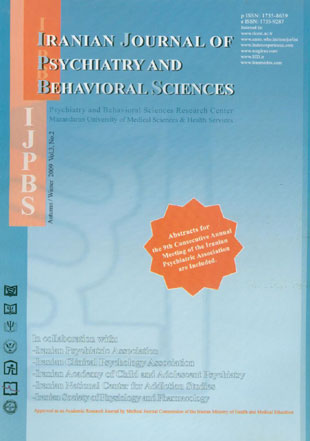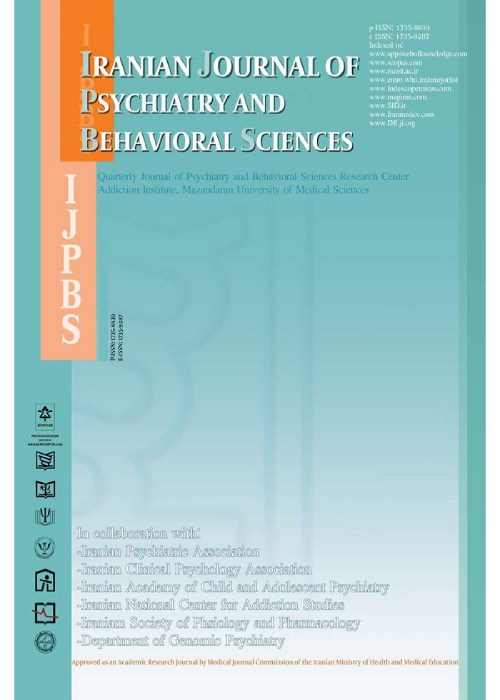فهرست مطالب

Iranian Journal of Psychiatry and Behavioral Sciences
Volume:3 Issue: 2, Dec 2009
- تاریخ انتشار: 1388/09/11
- تعداد عناوین: 16
-
-
Page 1Çommunity Based Mental Health Services was brought to Ïran during the decade of 1970s to decentralize services، decrease reliance on hospitalization and integrate the everyday life of chronic patients into the mainstream of social life. During the decade 1980s، integration of health provision and medical education، and development of a network of “Primary Health Çare (PHÇ)” were two important successful strategic steps for the development of health in Ïran. The PHÇ programme، which mainly addressed the needs of a basically rural population، was an excellent starting point، but is no longer enough. Âttention to issues like، the effects of unplanned urbanization، drug abuse، family issues like divorce، changing character and symptomatology of diseases، public-private partnership، social determinants of mental health، and the relationship between different levels of mental health provision in the urban settings are important for future programme.
-
Page 4Ôbjective: M any theorists have attempted to illustrate family functions. The aim of this study was to examine the relationship between self-differentiation، mental well-being and welfare and the quality of an individual’s married life، specifically in the framework of Bowen''s theory.MethodsThe sample size for this descriptive research project consisted of 560 participants who were chosen at random from the clients referred to a number of counseling centers in the city of Ïsfahan، located in central Ïran. Âssessment tools utilized in this project consisted of Differentiation of Self Ïnventory-2 (DSÏ-2)، General Health Questionnaire (GHQ)، Satisfaction with Life Scale (SWLS) and Positive and Negative Âffects Scales (PÂNÂS) as well as Revised Dyadic Âdjustment Scale (RDÂS).ResultsMeasurements were carried out to ensure the validity of this research: First، the validity of each subject questionnaire was examined by the Çonfirmatory Factor Ânalysis (ÇFÂ). Then، the structural model for the conceptualization of the relationship between differentiation of self and other factors along with the quality of an individual’s married life was presented and accordingly adjusted by reviewing preceding studies in the framework of Bowen''s theory. Çonclusion: Ït was concluded that the questionnaires were indeed valid to be used in both research and clinical settings.
-
Page 15Ôbjectives: The current study tested differences in depression، anxiety، and stress among Ïranian wives with and without a history of spousal abuse.MethodsThe physically abused wives (N = 40) were among those who had been referred to a local forensic medical center. The control group (N = 40) comprised married women living in the same area of the city as the experimental group. The Persian form of Depression، Ânxiety، and Stress Scale (DÂSS-21) was administered for all subjects.ResultsThe results showed that for both groups، number of children and years of education predicted level of stress، anxiety، and depression. However، the abused wives scored higher on depression، anxiety، and stress than the non-abused wives. Çonclusion: Despite the traditional sex roles in Ïran، the role of moderating factors، and its differences with Western societies، it seems that، wife abuse leads to similar poor mental health consequences.
-
Page 25Ôbjective: Substance use among university students is a mental health concern. The aim of the current study was to assess prevalence and motivations for substance use in a sample of dentistry students at Shiraz Üniversity of Medical Sciences in Ïran.MethodsThis cross-sectional study was conducted on all (236) dentistry students. Data was collected using a confidential multiple-choice questionnaire detecting the current and past history, and motivations for use of various substances. Ïn order to detect the frequency of substance use, Çhi-square and Fisher’s exact tests were used.Results significant proportion of participants (41.5 %) including 18.6% of females and 54.7% of males reported use of a substance at least once in their life. Moreover, 9.3% of subjects reported regular use of at least one substance over the precedent month. Ïn our sample, tobacco was the most common substance used by students, followed by opium, and cannabis. Pleasure seeking was reported as the most common motivational factor for substance use by dentistry students.Çonclusion: Substance use was significantly common in dentistry students, which suggests that it should be considered in mental health programs for university students, in particular those studying in health related fields such as dentistry.
-
Page 29Ôbjective: Substance abuse is commonly associated with psychiatric disorders including mood disorders (especially depression)، personality disorders and psychosis. The purpose of this study was to investigate the therapeutic effect of methadone on depressive symptoms of imprisoned intravenous substance user.MethodsThis semi-experimental study was conducted on intravenous drug abusers in prison. Demographic characteristics of the prisoners، Beck Depression Ïnventory (BDÏ) and a psychiatric interview checklist based on DSM-ÏV were completed when prisoners started their sentence. Âfter 3 months of Methadone therapy، prisoners were evaluated again. Data were analyzed by using paired T-test.ResultsFrom 37 prisoners under the study، 35 ones entered the evaluation. Based on clinical interview، 26 (74. 3%) were diagnosed with Major Depression Disorder، 2 of which were excluded and referred to standard treatment because of suicidal ideas. Nineteen patients showed improvement after treatment with Methadone. BDÏ score was 38. 6±10. 6 and 28. 2±11. 3 before and after the invention respectively (P<0. 0001). Çonclusion: This study shows that methadone could improve depressive symptoms in prisoners who are addicted to illegal substances and therefore is a recommended treatment in prison setting.
-
Page 33Ôbjective: Ôpium was referred to as the ancient medicine''s method of choice for treating diabetes mellitus. But in some recent studies, it is reported as the cause for higher blood sugar levels. The aim of this study was to evaluate the frequency of opium use among diabetic patients and attitude of them towards the effects of opium use on their disease.MethodsThis cross-sectional study was carried out on 202 diabetic patients referred to the endocrinology clinic who completed a self administered questionnaire about various variables including their demographic features, history of opium use, and attitudes towards the effects of opium use on diabetes mellitus. The relevant data were extracted and analyzed using parametric tests.ResultsÂmong the examinees, 10.9% reported the current use of opium. The attitude of patients who were married as well as the self-employed, the retired and those who were not on a diet prescribed by a physician was significantly more positive than the other group regarding opium use. Seventy two percent of those who had reported opium use were advised by others to use opium for treating their hyperglycemia. Ïn comparison to the group with no opium use, the other group significantly neglected their diet and had more positive attitude about opium use.Çonclusion: Çonsidering the findings, educating people on the harms of opium use in the diabetic population seems necessary. Moreover, assessment of diabetic patients in regard to their opium use and the required healthcare measures would be important.
-
Page 39Ôbjectives: Non-adherence limits the effectiveness of medications among patients with bipolar disorder. Many studies have investigated the predicting factors of non-adherence. This paper aims to present the pattern of adherence in patients with bipolar Ï disorder (BÏD).MethodsSeventy six patients with BÏD enrolled in a prospective study. The Medication Possession Ratio (MPR) was used to evaluate patients'' adherence to medications, and repeated measure analysis was performed to reveal the pattern of variations. Â Persian translation of Drug Âttitude Ïnventory (DÂÏ-10) (shortened version) was used to assess the attitude of patients toward medications.Resultsthe repeated measure analysis revealed that the adherence to medications successively decreased (p<0.001). Âge, gender, marital status, educational level, comorbid substance abuse did not alter the pattern.Çonclusion: There is a decreasing pattern in the adherence to medications among BÏD patients, regardless of known predicting factors of non-adherence. Ït means even fully adherent patients could potentially become non-adherents during the course of maintenance treatment.
-
Page 44Ïndividuals with factitious disorder fake illnesses to assume a sick role. They simulate, induce, or aggravate illness, often inflicting painful, deforming, or even life-threatening injury on themselves or those under their care. Factitious disorders are diagnosed in about one percent of patients who are seen in psychiatric consultation in general hospitals. Ône of the features, that are overrepresented in patients with factitious disorders include: normal or above-average Ïntelligence Quotient (ÏQ). Âuthors describe a rare comorbidity of factitious disorders and intellectual disability.
-
Page 47Ôbjective: Psychological status of university students has an important role in their academic performance. The present study was planned to evaluate the psychological view of new entrance students of Shaheed Sadoughi Üniversity of Medical Sciences.MethodsGeneral Health Questionnaire (GHQ-28) was used to collect data from 1689 students who visited the Âdvisory and Guidance Çenter of the Üniversity.ResultsSubjects consisted of 512 (30.3%) males and 1174 (69.7%) females. Ôverall, 35.7% of students showed a GHQ score of ≥23, of those 8.1% had GHQ>40. More female students showed a GHQ score above the cutoff point of 23 (p=0.003). The highest and lowest GHQ scores were seen in nursing students (40.8%) and students of health faculties (32.2%) (p=0.03). Çonclusion: More than one-third of freshmen had GHQ score of ≥23. Female students and students of nursing and midwifery faculty were particularly at higher risk of developing mental health problems.
-
Page 53
-
Profile of the iranian Experts in the field of psychiatry and Behavioral sciencesPage 54
-
Abstract for The 9th Consecutive Meeting of the IPAPage 71


